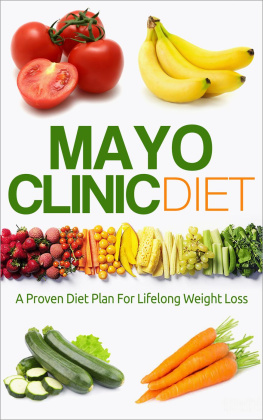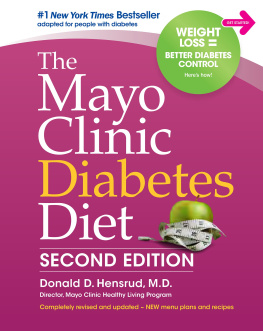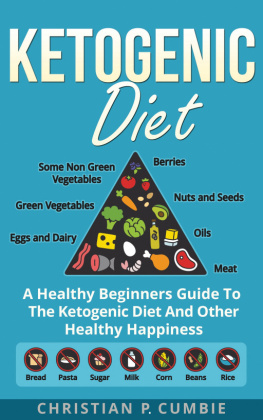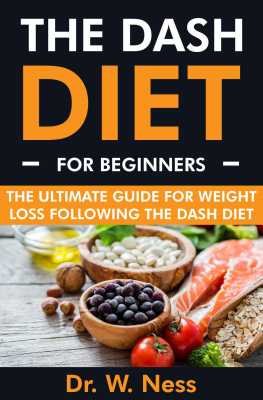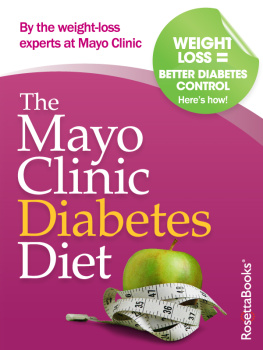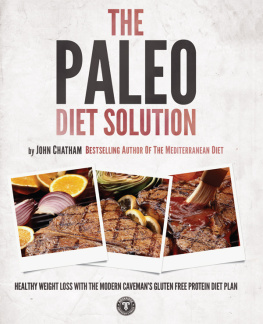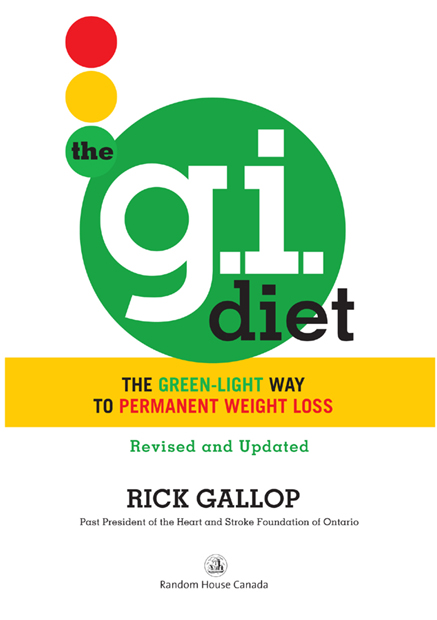PUBLISHED BY RANDOM HOUSE CANADA
Copyright 2011 Green Light Foods Inc.
All rights reserved under International and Pan-American Copyright Conventions. No part of this book may be reproduced in any form or by any electronic or mechanical means, including information storage and retrieval systems, without permission in writing from the publisher, except by a reviewer, who may quote brief passages in a review. Published in 2011 by Random House Canada, a division of Random House of Canada Limited, Toronto. Distributed in Canada by Random House of Canada Limited.
www.randomhouse.ca
Random House Canada and colophon are registered trademarks.
Library and Archives Canada Cataloguing in Publication
Gallop, Rick
The G.I. diet, 10th anniversary / Rick Gallop.10th anniversary ed.
eISBN: 978-0-307-36154-7
2. Reducing diets. 3. Reducing dietsRecipes.
I. Title.
RM222.2.G34 2011 613.25 C2011-906074-4
v3.1
Contents
Introduction
Since the original G.I. Diet was published ten years ago, over two million copies have been sold in twenty-three countries and seventeen languages, making it the most successful diet and health book in Canadian publishing history.
Perhaps our biggest surprise was both the quantity and quality of feedback from our readerssome 70,000 e-mails! While most of the e-mails talked about how successful the G.I. Diet has been for them, it has become increasingly clear that long-term success depends a great deal on peoples ability or willingness to change eating behaviours and lifestyle. The most common refrain was Please dont call this a diet; its a lifestyle change.
What also has become apparent is the importance of how personality traits can influence peoples approach to food and their long-term success in making a permanent change to a healthy eating lifestyle.
A simple example: Think about how you approach a buffet: do you plunge in and overload your plate without a second thought? Or do you think, Ill make up for it tomorrow? Perhaps you think it doesnt matter: No matter what I do, Ill fail, or you analyze the buffet table then carefully select minute, carefully calculated samples, worrying that you have the precise correct amount? Each of these approaches to that buffet suggests specific personality traits.
Whether you are impulsive, wishful, helpless or controlling, there is little you can do to change your personality. However, this book will help you identify your specific personality traits, examine how they contribute to eating behaviours, and outline how you can use this knowledge to your advantage and modify the potentially negative influences of these characteristics.
The original G.I. Diet promised that you wouldnt go hungry or feel deprived; it is a plan that is simple, not time consuming, and promotes wellness and boosting energy levels. The new, revised G.I. Diet couples all these benefits with a personality-driven guide to changing food behaviours to help make permanent weight loss even easier.
Please visit our website www.gidiet.com for the latest updates and details of all the other books in the G.I. Diet series including:
The G.I. Diet Cookbook with over 200 delicious green-light recipes.
The G.I. Diet Guide to Shopping and Eating Out, which conveniently fits into pocket or purse.
The G.I. Diet Express for busy people.
a series of books based on e-clinics we conducted: The G.I.Diet Clinic (directed at big people), The G.I. Diet Menopause Clinic and the G.I. Diet Diabetes Clinic.
You may also contact us through our website; we very much look forward to receiving your comments or suggestions.
R ICK AND R UTH G ALLOP
HOW TO USE THIS BOOK
The first few chapters of the book introduce the principles of the G.I. Diet and explains how it works. You will learn how much weight you should lose and what you can eat, how much and when.
The rest of the book shows you how to put the G.I. Diet into practice. It will help you prepare delicious meals and snacks at home and guide you in making the right choices when dining out. In addition, weve given you the tools to enable you to determine your own personality characteristics and discover how this will help change your eating behaviours and habits that are essential for permanent weight loss.
Chapter One
The Problem
While I was waging my personal battle of the bulge, I couldnt help but be struck by the number of people who were engaged in the same struggle. The statistics are truly astonishing: over 60 percent of Canadian adults today are overweight. Thats more than double what it was only ten years ago. Even more worrying is the tripling of the obesity rate among children over the past twenty years. Whats happened to us? Why have we gained so much weight in recent years?
The simple explanation is that people are eating too many calories. Unless one denies the basic laws of thermodynamics, the equation never changes: consume more calories than you expend and the surplus is stored in the body as fat. Thats the inescapable fact. But that doesnt explain why people today are eating more calories than they used to. To answer that question we must first understand the three key components of any dietcarbohydrates, fats and proteinsand how they work in our digestive system. Since fats are probably the least understood part, lets start with them.
FATS
Fat is definitely a bad word these days, and it engenders an enormous amount of confusion and contradiction. But are you aware that fats are absolutely essential for a nutritious diet? They contain various key elements that are crucial to the digestive process.
The next fact might also surprise you: fat does not necessarily make you fat. The quantity you consume does. And thats something thats often difficult to control, because your body loves fat. Non-fat foods require lots of processing to be transformed into those fat cells around your waist and hips; fatty foods just slide right in. Processing takes energy, and your body hates wasting energy. It needs to expend about 20 to 25 percent of the energy it gets from a non-fat food just to process it. So your body definitely prefers fat, and as we all know from personal experience, it will do everything it can to persuade us to eat more of it. Thats why fatty foods like juicy steaks, chocolate and decadent ice creams taste so good to us. But because fat contains twice as many calories per gram as carbohydrates and proteins, we really have to be careful about the amount of fat we eat.
In addition to limiting how much fat we consume, we must also pay attention to the type of fat. While the type of fat has no effect on our weight, it is critical to our healthespecially heart health.
There are four types of fat: the best, the better, the bad and the really ugly. The bad fats are called saturated fats, and they are easily recognizable because they almost always come from animal sources and they solidify at room temperature. Butter, cheese and meat are all high in saturated fats. There are a couple of others you should be aware of too: coconut oil and palm oil are two vegetable oils that are saturated, and because they are cheap, they are used in many snack foods, especially cookies. Saturated fats are a principal cause of heart disease because they boost cholesterol, which in turn thickens arteries and causes heart attack and stroke. And recent research has demonstrated that several cancersbreast, colon and prostateas well as Alzheimers are associated with diets high in saturated fat.


